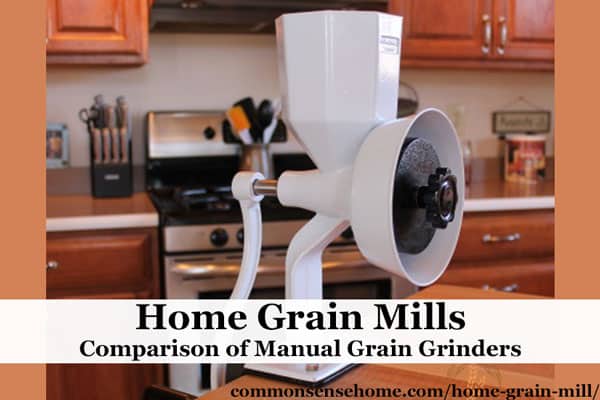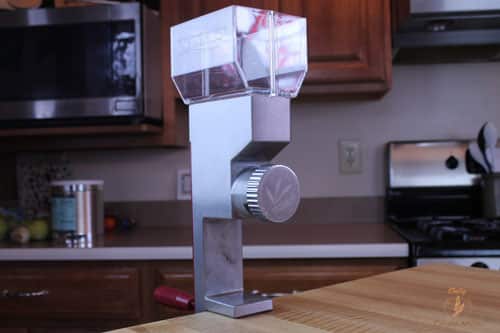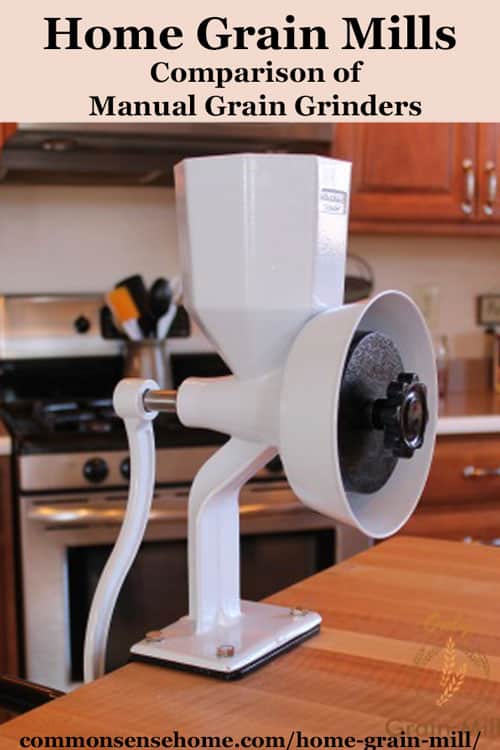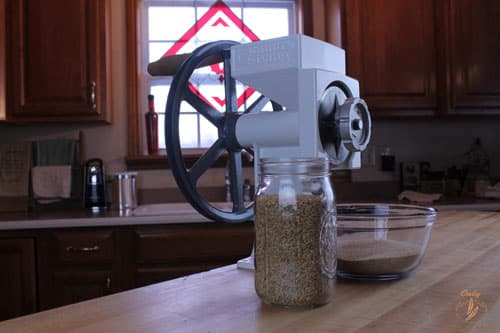Home Grain Mills – Comparison of Manual Grain Grinders
This post may contain affiliate links. Read my full disclosure here.
Whole grains are affordable, last longer in storage and can provide excellent flavor and quality. That said, you can’t use these grains to their full potential without a home grain mill. Manual flour mills tend to be less expensive than their powered cousins, but still get the job done. For light amounts of grain grinding or an off grid situation, a manual grinder is a solid choice.

What is a Grain Mill?
Essentially, flour milling remains unchanged from what Ancient Egyptians or even the American colonials used in their day. Two rough surfaces (usually stones) grind against one another to pulverize the wheat or other material into a powder.
Previous generations had issues such as millstone grit in their breads that wore down their teeth. Thankfully, modern grain mills take the concept of grinding surfaces and use modern materials and technology to produce a clean, consistent product.
Modern home grain mills:
- Can be powered either by hand or by electricity
- Use a variety of materials ranging from composite stones to surgical and stainless steel burrs
- Grind a wide variety of ingredients into highly nutritious ingredients and foods
- Are typically quite durable and portable
Why Do I Need a Grain Mill?
There are a variety of reasons, depending on your focus and needs, to keep a grain mill handy in your kitchen.
Freshly Ground Flour Provides Better Nutrition
Modern flour is a highly processed food. Most of the inner portions of the wheat berry (the parts necessary for the initial burst of nutrition the plant would need) are removed in order to keep the flour fresh for months on a store shelf. The resulting flour is then “enriched” with artificial vitamins to make up the difference.
Compare this nutritionally-deficient industrial stuff to flour you grind at home. Since you don’t need to keep flour on a shelf in a bag for weeks, you can grind up enough for each recipe as you need it. The original nutrients stay in the flour – no enrichment required.
Use your home milled flour to make bread, cakes, and cookies, and store the rest of the wheat until needed. (To get even more nutrition, check out working with sourdough recipes such as sourdough bread and crackers.)
You Can Be More Self-Sufficient (Now and During Emergencies)
Buying grain in bulk is cheaper than buying flour. You can also store grain for decades if you stash it properly. (Read more on buying grains in bulk and proper storage here.)
This means that money spent now on food will feed your family for many years to come. Food prices tend to go up, not down, so this is a good investment.
If our economic or political situation turns dark and it becomes a major undertaking to go to a store and buy food (presuming food is available, of course), long term food storage will be even more important. (Venezuelans can testify to this.) In that case, having a grain mill that you can use to grind flour will help keep you and your family fed.
In a short term emergency with an extended power outage, you’ll want manual tools to get jobs done. The right grain mill can tackle not only grain, but tasks like grinding peanut butter, too.
You can make your own flour, grind corn meal, grind coffee (including herbal coffees), make peanut butter or seed butters… Once you get in the habit of using it, you’ll wonder how you did without it.
Have More Uses for the Materials You Grow Yourself
A sturdy mill isn’t just for grinding wheat and rice. You can also use it as a corn grinder to make your own corn meal, or to grind dried beans for bean flour. Sunflower seeds, pepitas, almonds, peanuts and a variety of small grains can all be ground for flours or spreads.
Which Home Grain Mill is the Best for Me?
That question only you can answer, since only you know the needs unique to your situation. However, here are some pros and cons of popular manual grain mills.
Would you like to save this?

The Victorio Brand (AKA Back To Basics)
The Victorio brand comes in two flavors, the Basic and the Deluxe. The Basic is best suited to be a backup mill, though in a pinch it could be the main mill for a single person. It’s bigger brother the Deluxe can be a main mill for a couple, though again I’d rather use it as a backup.
- They grind easily, and the grind gives you good quality bread flour. You can also grind more coarsely for cereals and such.
- Both units clamp to a sturdy surface using a table clamp on the bottom of the mill.
- They cannot grind whole corn kernels and cannot handle hard popcorn at all. Best for wheat or rice, since they cannot handle anything with oil or moisture content.
- If you plan on grinding sprouted wheat be sure to dry it out thoroughly first, or the residue will eventually clog the Victorio mills.
- They come with 2 year manufacturer’s warranties, and are excellent buys for the money. However, a family will need a more durable mill since these mills only recommended for occasional small-quantity grinding.

The WonderMill Junior Deluxe
The WonderMill Junior Deluxe is an excellent mix of durability, versatility, and portability.
- The double-clamp it uses for stability is very gentle on the table edge (provided it’s not over-tightened).
- Fully assembled it weighs about 10 pounds, owing to its lightweight aircraft-aluminum body.
- The food-grade coating keeps the aluminum from contacting the food, and since there’s nothing that can rust in the grinding mechanism, it’s easy to clean off flour dust and the like just by running the whole mill under a faucet.
- The best part of the WonderMill Junior Deluxe is the grinding burrs.
The Deluxe comes standard with two sets of burrs: one stone for dry grains like wheat and rice, and the other a stainless steel set meant for oily grains, coffee beans and fresh peanut butter.
It’s the only mill that can boast excellent grinding of such a wide range of ingredients, from hard popcorn to oily and gooey peanut butter, just by switching the burrs around for the proper grind.
It grinds finely, giving you high-quality bread flour or very smooth peanut butter, and can be backed off to grind coarse if you want cornmeal and other grittier foods.
It has a limited lifetime warranty, which covers everything but the wearable stone burrs and the brass bushings. I’d recommend this mill for anyone, as it covers most needs and will last a long time.

The Country Living Grain Mill
The Country Living Grain Mill is a famous mill, and for good reason: it’s one of the largest and most durable mills on the market. Weighing in at 20 pounds and covered by a limited lifetime warranty, it is best described as solid.
It has been made in the U.S.A. for decades, and for grinding dry grains there is no better mill. It’s burrs are made of stainless steel and specially designed to get you one of the finest grinds possible on a grain mill.
It doesn’t include a clamp (though one is optionally available) because most people prefer to bolt it directly to their grinding surface to take advantage of its finely machined grinding mechanism for motorizing with the included pulley.
I’ve seen Country Livings attached to motors or to exercise bikes: the smooth action of the mill makes it excellent for motorizing. Its only weakness is oily seeds, as it is rather hit-or-miss with them.
Some of the less oily seeds it seems to handle alright, but something like coffee or peanut butter will gum it right up. Recommended for motorization option and/or for anyone who wants to grind dry grains.
You may also enjoy:
- 13 Homemade Bread Recipes – Never Buy Bread Again
- Troubleshooting Tips to Help Bake the Perfect Loaf of Bread
- Best Ever Corn Bread Recipe
- Nutrimill Grain Mill Comparison (for an on-grid option instead)
This post was originally written in cooperation with the company “Only Grain Mills” back in 2013. It was updated in 2015 and 2017 with more detailed content and links to their site removed. I no longer recommend their shop. Two readers ran into problems when ordering from them. They are the reason we rarely partner with companies unless we can test a product or service first.
